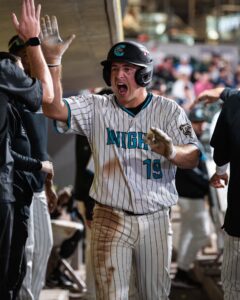A proposal: Courtney Hawkins, pitcher
Is it such a crazy idea?
In truth, originally it wasn’t even my idea. It was suggested in a thread on SoxTalk, and while I chuckled for a moment at first, the idea started to grow on me.
I am usually skeptical of suggestions for prospects to change positions. Often those posits fail to fully appreciate the difficulties in such a shift. For example, I wrote an article in 2015 that made a detailed argument of why converting Micah Johnson to the outfield would be a mistake. So this is not a idea I am throwing out there flippantly.
But the more I thought about this particular proposal, the more it made sense.
As those in the medical profession are taught early on, a key maxim is “first do no harm”. In Johnson’s case, he was a semi-significant prospect, and any major shift in his focus and tasks carried risk to that profile.
In Courtney Hawkins‘ case, to be frank, there is very little prospect stock to lose. The soon-to-be 23-year old outfielder repeated AA in 2016, putting up nearly identical numbers to his 2015 at the same level. Scouting reports universally point out an inability to judge pitches appropriately, and as a result, Hawkins’ strikeout rate has been above 30% each of the past two years and hasn’t been below 27% since his draft year cameo. Iterations of mechanical changes have made minimal or no positive impact in the past few years. As a hitter, he has shown in four straight full seasons that he’s not progressing in a way that warrants serious consideration for a future major league job. While his raw power remains tantalizing, every indication is that he won’t make enough contact for it to carry him.
So what makes me think this former 13th overall draft pick can pitch instead?
He certainly has the arm strength for it. In high school, the Texan was a two-way player. As a pitcher, he could hit low 90’s with his fastball and posted a sub-1 ERA his senior year. Scouting reports as a pro indicate he still shows above average to plus arm strength from the outfield. The saying goes, “you can’t teach velocity”, and it certainly appears he’s got that naturally. Some time on the mound and getting acquainted with pitching regularly again would likely result in a further uptick in velo, though it’s impossible to say just how much.
In terms of physical build, he has some of what you want to see in a hurler. His 6’3″ height makes him average or a hair taller among pitchers. He is currently listed at 245 pounds, and has a strong base to work from – something most pitching coaches, especially those with the White Sox, emphasize in building their machines. His occasional bouts with use injuries like hamstring strains and plantar fasciitis are concerns, though perhaps a pitching-focused training regimen (and less hard stop and start running) could help alleviate that. The recent addition of weight may have reduced his foot speed, but there is still plenty of athleticism here.
What does history tell us? In terms of converting position players, the penultimate White Sox example might be Sergio Santos, who went from infielder to successful MLB reliever (until injuries sidelined him). There are more examples where the jury is still out. Jacob Morris made the move from the outfield to the mound and is slowly marching up the system. Thaddius Lowry had planned to go to college potentially as a catcher (he was a two-way player in high school), and is now a notable pitching prospect. The best parallel may be Louie Lechich, who much like Hawkins was an outfielder who just wasn’t hitting enough. He was converted midway through the 2016 season, and so far in his first 22 professional innings across AZL, A-ball and the AFL he’s yet to allow an earned run. So there is certainly precedent here, with a mix of results.
What about the environment? The White Sox have struggled mightily to develop hitters, but have a much better track record with pitchers. Up and down the system, pitching coaches like Rich Dotson (now the pitching coordinator), J.R. Perdew, Jose Bautista and Matt Zaleski get rave reviews not just from the White Sox, but independent analysts and scouts as well. The system certainly appears to be fertile ground.
There are a few other, smaller points of note as well. Hawkins has a reputation for putting in the work, and that work ethic will certainly be needed to make this sort of fundamental change. with 4.5 years of pro ball and playing up through AA, Hawkins has been around the block enough times to have experience on his side, but young enough to still have prime years in front of him.
Crazy as it might seem on the surface, Courtney could have a better chance at providing value in the majors with his arm than his bat. So don’t be shocked if at some point in the next year or two, you see the words “RHP Courtney Hawkins“.
Want to know right away when we publish a new article? Type your email address in the box on the right-side bar (or at the bottom, if on a mobile device) and click the “create subscription” button. Our list is completely spam free, and you can opt out at any time.







Can’t hurt. The hitting thing is certainly not working.